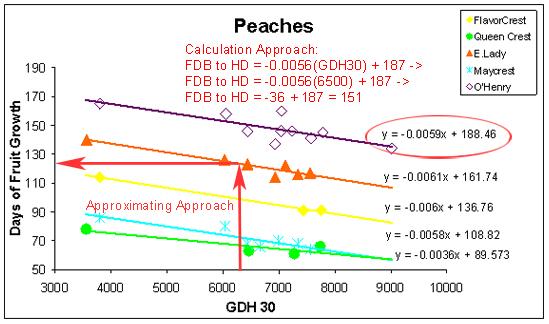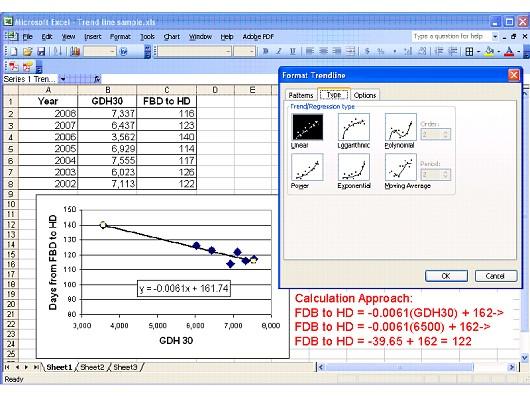Harvest Prediction: Predicting Harvest Date
Using Growing Degree Hours | Predicting Harvest Date | GO TO THE MODEL | References
There are three approaches to using the GDH30 accumulation figures for your location to predict an approximate harvest date: using a rough threshold estimate, using established models developed from historical data by previous research, or using your own site-specific trend calculations to generate your own model.
Threshold Estimating
It’s been found that 6,000 GDH is a threshold for changing maturation behavior. Accumulation of much more than 6,000 GDH in the first thirty days after bloom leads to earlier harvest dates and smaller fruit size under normal thinning practices. If the GDH30 accumulation figure shown for your location and bloom date this year is above 6,000, it’s recommended you thin fruit earlier than usual and anticipate an earlier harvest than normal. (
Lopez G and DeJong TM., 2008
;
Lopez G and DeJong TM., 2007
).
Established Models
The relationship between GDH30 and the number of days between full bloom (FBD) and harvest (HD) has been quantified for a number of different cultivars of peaches, plums, prunes and nectarines based on historical data from a number of years and locations throughout the state (
Ben Mimoun M and DeJong TM, 1999
; DeBuse et al., In Press). Though the exact numbers for every cultivar have not been calculated, the fact that GDH30 and FBD to HD are related is true for all cultivars. Preliminary data suggests that cultivars with similar chill requirements and similar maturation timing have similar slopes, with low chill cultivars having steeper slopes than medium chill cultivars. Given the GDH30 figure generated for your location and bloom date, you can use the models shown below to estimate the harvest date.
To get a ball-park figure of the days between full bloom and harvest for this year, find your cultivar of interest, or one with a similar chill requirement, approximate the GDH30 value’s location on the x-axis, and based on the modeled relationship approximate the associate number on the y-axis (see example below). Add the number of days to your FBD for this year to get an approximation of this year’s HD.
The equations in the figures below show the slope and intercept that was calculated for each cultivar following the formula Days from FBD to HD = (slope x GDH 30) + intercept. If an equation for your cultivar of interest is shown in the graph, you can get a more exact estimate by plugging in your GDH30 to calculate HD (see example below). If your cultivar is not shown here, you can plot your historic data of days between full bloom and harvest and GDH30 for the last five years onto the graph, see which cultivar your records best line up with and use that cultivar as an approximation.

Figure 1. Example of finding Days of Growth using GDH30 = 6,500 and existing O’Henry model. ( Ben Mimoun M and DeJong TM, 1999 )
It has recently been found in peach and nectarine models that cultivars of approximately the same chill requirement have the same slope ( Day et al., 2008 ). If you are calculating for peaches and nectarines with a medium chill requirement, you may wish to use this more simplified approach. The table Peach and Nectarine Common Slope Models provides the intercept, cultivar parameter and slope. Research to similarly refine the models for other stone fruits is ongoing.
Generating Your Own Model
You can also use the GDH30 data for your area and bloom dates and your own harvest date records to approximate your own trend line. Gather data from at least five or six years to generate an accurate model and enter them into a calculator or computer spreadsheet. Set your GDH30 figures as the independent variable (x axis) and Days between Full Bloom and Harvest as your dependent variable (y axis), then use the linear regression function to generate a model line with an equation in the format of Days from FBD to HD = (slope x GDH 30) + intercept and plug in your GDH30 figure for this year [see example below using Excel and the XY (Scatter) graph function].

Figure 2. Example of regression formatting to generate your own model.
